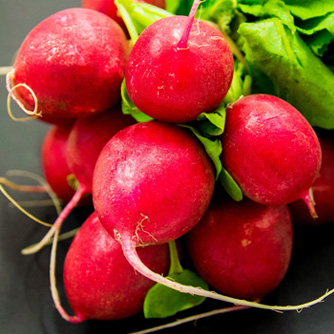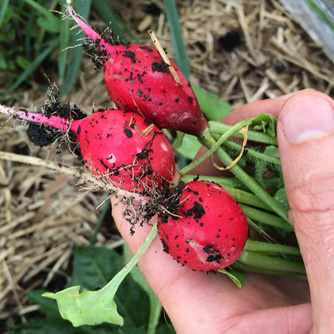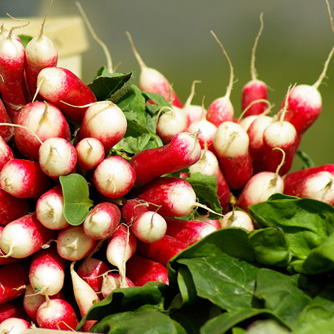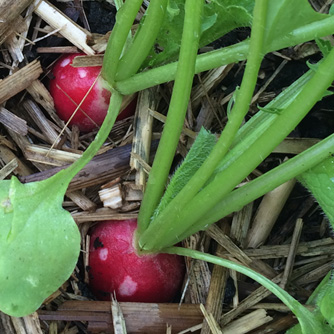Radishes
BackRadishes are grown for their tasty swollen root and are the best ingredient to add a bit of pizzazz to your salads. These fast growers are incredibly easy and perfect for the novice veggie grower. They even do well in pots if you’re limited with space.
The commonly grown radish is red skinned with a white centre and has a peppery spicy flavour but there are plenty of other types to try. The Chinese ‘Watermelon’ radish has white skin and a vivid pink centre while the ‘Black Spanish’ radish has black skin and a white centre. Depending on the variety grown radishes can be used raw in salads or cooked in soups and stews to add a nutty, spicy taste.
Types of Radishes
Radishes can be divided into several main groups:
- Summer varieties which mature quickly and have round or cylindrical roots. They are mainly eaten raw in salads and are the most commonly grown types in Australia. They are also known as French Maturing radishes.
- Winter varieties take longer to develop and are usually treated more like turnips being cooked in stews and soups.
- Oriental varieties that can take twice as long to mature as the winter varieties and are usually cooked or pickled.

Radishes ready to eat!
How to Grow Radishes
Select a sunny position that has some afternoon shade if growing through summer. All day hot sun can make some radish plants ‘bolt’ into flowering before the root fully develops.
Radishes will grow best in a friable well draining soil as this allows for even root development. Work in some compost or aged manure to boost nutrient levels before sowing seed. It’s important that the manure is not fresh as this can burn the root tips and cause the roots to fork.
Sow seed directly into the soil and water in with OCP eco-seaweed to encourage germination and strong seedlings. Germination is quick and very reliable. Keep the soil moist as radishes grow to ensure a sweet harvest but don’t over water as this causes excess leaf growth at the expense of root growth.
Sowing Guide for Radishes
| Growing Zone | Sowing Time |
| Cool Zones | Spring, Summer, Autumn |
| Mediterranean Zones | Spring, Summer, Autumn, Winter |
| Warm & Temperate Frost Free Zones | Spring, Summer, Autumn, Winter |
| Tropical & Subtropical Zones | Spring, Summer, Autumn, Winter |
Sow seeds every 2-4 weeks to give you a continuous harvest of tasty radishes

Freshly pulled radishes
Fertilising Radishes
Ideally work in compost or aged manure before sowing seeds to improve the soil. If you’re short for time you can also just sprinkle some certified organic fertiliser pellets on the top of the soil at the time of planting. To really push plants along water in a mixture of OCP eco-aminogro and OCP eco-seaweed every 2-3 weeks and you will be rewarded with a crop of sweet, crisp radishes.
Harvesting Radishes
You should be harvesting summer radish about 6 weeks after planting. At this early stage the roots will have filled out but will still be sweet and tender. The longer they’re left in the ground the tougher the roots become.
With winter radish, the roots tend to take longer to develop so allow about 9 weeks to maturity or be guided by the seed packet. Again if left too long they will become hollow and stringy.
Store the pulled radishes in the refrigerator crisper where they’ll keep for up to 7 days.

French Breakfast radish is cylindrical shaped with a white end
Pests and Diseases of Radishes
There are few problems with radishes but keep a look out for:
- Caterpillars – pick off by hand.
- Snails and slugs – young seedlings are most at risk so watch out for the classic slime trails. Use OCP eco-shield to keep seedlings safe.
- Earwigs and slaters – they may have a little chomp on the root top that is poking out of the soil but the damage is usually minor. If it troubles you remove the mulch to take away their daytime hiding spots. If slater numbers get out of hand and start causing major damage then apply OCP eco-shield pellets to control them.
- Split roots – usually caused by uneven watering so aim for good regular waterings.
- Aphids - clusters of these sap suckers can be controlled with an organic insecticide.

Superficial nibbling on radish root (white spots)


